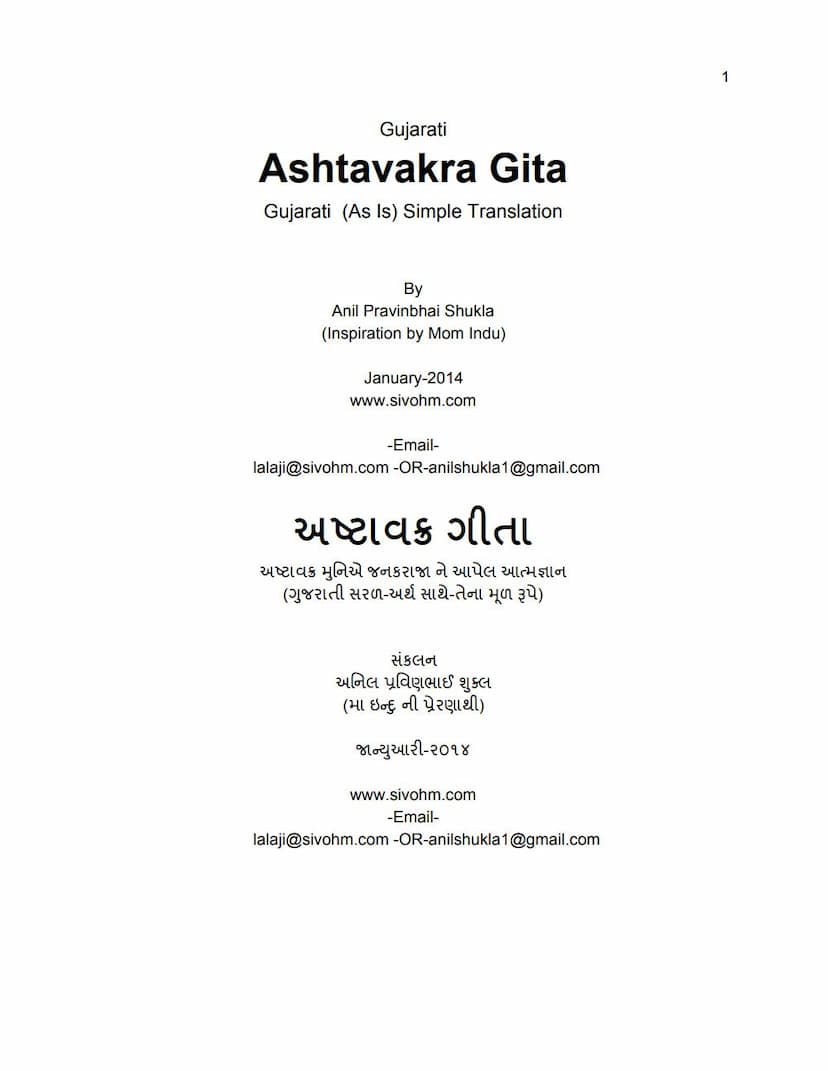Ashtvakra Gita
Added to library: September 1, 2025

Summary
This document is a Gujarati translation with simple explanations of the Ashtavakra Gita, compiled by Anil Pravinbhai Shukla, inspired by his mother Indu. The Ashtavakra Gita is a discourse given by the sage Ashtavakra to King Janaka, focusing on self-knowledge and liberation.
The text is structured into 20 chapters, each containing verses that convey profound spiritual insights. Here's a summary of the key themes and teachings presented in the provided pages:
Core Message: Realization of the True Self (Atman)
The central theme throughout the Ashtavakra Gita is the realization that the true self is the Atman, which is eternal, pure consciousness, unchanging, and distinct from the physical body and the material world. The text guides the seeker away from identification with the transient and towards the immutable Atman.
Key Teachings and Concepts:
- Liberation (Mukti): Liberation is attained through self-knowledge (Atma-gyan) and detachment (vairagya). It's not something to be achieved, but a realization of one's already existing freedom.
- Detachment from the Material World: The material world, including the body, senses, and worldly possessions, is repeatedly described as illusory, like a dream or a mirage. One must detach from these to find true happiness.
- The Nature of the Atman: The Atman is described as the witness (sakshi), all-pervading, formless, unchanging, and the source of all existence. It is not the doer (karta) or the enjoyer (bhokta) of actions.
- The Illusion of Bondage: Bondage is not inherent but arises from ignorance and identification with the body and the ego ("I am the body," "I am the doer"). The text emphasizes that one is inherently free.
- The Power of the Mind: The mind, with its desires, thoughts, and attachments, is identified as the root cause of suffering and bondage. By controlling and transcending the mind, one can achieve liberation.
- Discrimination (Viveka): The ability to discriminate between the real (Atman) and the unreal (the world) is crucial for spiritual progress.
- Equanimity: Maintaining a state of equanimity amidst dualities like pleasure and pain, gain and loss, life and death, is a hallmark of the liberated soul.
- Non-duality (Advaita): The ultimate realization is that there is only one consciousness (Brahman/Atman) pervading everything. The world and the individual self are not separate from this ultimate reality.
- The Role of Knowledge: True knowledge is not merely intellectual understanding but a direct experiential realization of the Self.
- The State of the Liberated Soul (Jivanmukta): A liberated soul lives in the world without being attached to it, acting naturally without ego, desire, or aversion. They are unperturbed by external circumstances.
Structure and Content Highlights:
The initial chapters (1-3) establish the dialogue between King Janaka seeking knowledge and Sage Ashtavakra providing guidance. King Janaka expresses his astonishment at realizing his inherent freedom and the illusory nature of the world. Ashtavakra systematically dismantles the misconceptions about the self, emphasizing its true nature.
The subsequent chapters delve deeper into:
- The illusory nature of the world: Using analogies like ropes appearing as snakes, water in a mirage, or waves in the ocean, the text illustrates how the world is a projection of the mind and ignorance.
- The insignificance of worldly pursuits: The text dismisses the importance of wealth, status, and even scriptures or practices if they don't lead to the direct realization of the Self.
- The nature of desire and its cessation: Desire is identified as the primary driver of suffering. Its eradication through detachment and contentment leads to peace.
- The state of equanimity and detachment: The text describes the liberated individual as one who is neither overjoyed by pleasure nor distressed by pain, neither attached nor averse to anything.
- The role of scriptures and teachers: While scriptures and teachers can point the way, the ultimate realization must come from within.
- The absence of doership: The true Self is not the doer of actions. Actions are performed by the body-mind complex due to past karma and ignorance.
- The transcendence of dualities: The liberated soul transcends all dualities, including good and bad, pleasure and pain, life and death, bondage and freedom.
Overall Tone:
The Ashtavakra Gita, as presented in this translation, is a direct and profound guide to spiritual awakening. It challenges conventional thinking and urges the reader to look inward for the ultimate truth and freedom that are already present within. The simple Gujarati explanations aim to make these complex philosophical concepts accessible.